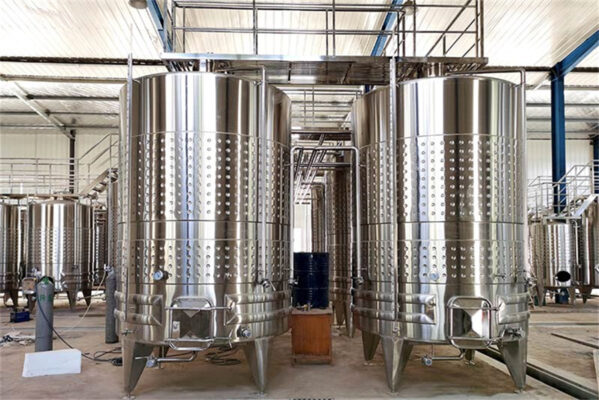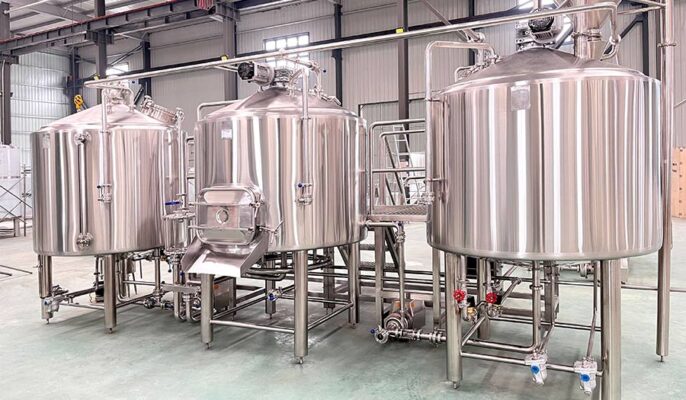Stainless steel brewery tanks are essential equipment for commercial beer production. In the heart of every brewery lies a symphony of stainless steel tanks, each playing a crucial role in transforming humble ingredients into beloved beers. These gleaming vessels are far more than just containers; they are the instruments that orchestrate the entire brewing process, from mashing and boiling to fermentation and conditioning.
Imagine towering cylindroconical fermenters, where yeast works its magic, separating spent grains for crystal-clear brews. Picture bright tanks polishing the beer to perfection, adding the finishing touches before packaging. Hot and cold liquor tanks provide the lifeblood of the process, while kettles witness the dance of hops and wort, infusing flavor and aroma.
But the orchestra doesn’t stop there. Specialized tanks cater to individual styles, from lagering tanks maintaining precise temperatures for crisp lagers to souring tanks nurturing unique flavor profiles. Each tank, carefully chosen for its specific role, contributes to the harmonious creation of diverse and delicious beers.
Types of stainless steel brewery tanks
Elaborate on the classification of Brewery Tanks
For breweries big and small, stainless steel tanks are the beating heart of the operation. More than just containers, they are the instruments that orchestrate the magic of transforming wort into beloved brews. However, venturing into the world of brewery tanks can seem daunting, with a bewildering array of shapes, sizes, and features vying for your attention. Let’s embark on a guided tour, exploring the types of stainless steel tanks and their roles in the brewing process.
The Main Stage: Workhorses of Fermentation
-
Fermenters: These are the stars of the show, where the magic of yeast transforming wort into beer happens. They come in diverse shapes and sizes, from towering cylindroconicals favored by large breweries to sleek unitanks popular with smaller operations. Cylindroconicals, with their iconic cone-shaped bottom, facilitate easier separation of spent yeast and sediment, leading to clearer beers. Unitanks, combining fermenter and conditioning functions, offer space-saving efficiency for smaller breweries.
-
Brite Tanks: After fermentation, beer undergoes conditioning and clarification in bright tanks. These polished vessels hold the finished beer, allowing it to settle further and achieve its final brilliance before packaging. Some feature carbonation systems, infusing the beer with its signature fizz.
Supporting Cast: Players Behind the Scenes
-
Mash Tuns: Here, the malted grains meet hot water, releasing their sugars to create wort. Mash tuns can be lauter tuns, featuring a perforated false bottom for separating the wort from spent grains, or combination mash/lauter tuns, streamlining the process.
-
Kettles: In these heated vessels, wort is boiled with hops, imparting bitterness, aroma, and flavor. Some kettles feature whirlpool capabilities, creating a gentle vortex to separate hop debris.
-
Hot Liquor Tanks (HLT): These tanks provide hot water for various stages of the brewing process, from mashing to cleaning.
-
Cold Liquor Tanks (CLT): Holding chilled water, CLTs provide a temperature-controlled source for cooling wort and maintaining consistent fermentation temperatures.

Specialty Acts: Catering to Diverse Styles
Beyond these core players, a plethora of specialized tanks cater to specific brewing styles and needs. Conditioning tanks hold beers for extended aging, while lagering tanks maintain precise cold temperatures for crisp lagers. Yeast propagation tanks cultivate healthy yeast cultures for future brews. For sour beers, dedicated souring tanks allow controlled exposure to bacteria for unique flavor profiles.
Choosing the Right Ensemble:
Selecting the right tanks depends on your brewery’s size, production volume, and desired beer styles. Consider factors like:
- Material: Most breweries opt for durable and sanitary stainless steel, with specific grades (like 304 or 316) depending on budget and brewing needs.
- Size: Tanks should be sized to accommodate your batch volumes and allow for headspace.
- Features: Do you need specific functions like carbonation, cooling jackets, or pressure capabilities?
- Budget: From basic tanks to feature-rich options, the price range varies significantly.
table of stainless steel brewery tanks’s type
| Tank Type | Purpose |
|---|---|
| Mash Tun | Mixing milled grains with hot water to extract sugars, starches, colors, and flavors |
| Lauter Tun | Separating sweet wort from spent grains |
| Kettle | Boiling wort with hops for sterilization, extraction, clarification and concentration |
| Fermenter | Conversion of sugars into alcohol and CO2 by yeast |
| Brite/Serving | Carbonation, clarification, storage and dispensing |
| Whirlpool | Removal of coagulated proteins, hops and break material |
Brewing Process Overview
The typical brewing process involves the following key stages that utilize stainless steel tanks:
| Step | Description |
|---|---|
| Ingredient Preparation | Gather materials such as malt, hops, water, and yeast. |
| Mashing | Mix malt with water and convert starches into fermentable sugars by heating and maintaining a certain temperature. |
| Lautering | Separate solid waste to obtain liquid wort suitable for fermentation. |
| Boiling | Boil the wort, adding hops to enhance bitterness and flavor. |
| Cooling | Rapidly cool the wort to prepare for fermentation. |
| Fermentation | Transfer the cooled wort to fermentation tanks, add yeast, and ferment it into beer. |
| Bottling or Canning | Package the matured beer into bottles, cans, or kegs for distribution and consumption. |
| Secondary Fermentation (if necessary) | Some beer styles require a second fermentation, usually in bottles, to enhance flavor and carbonation. |
| Packaging | Label, package, and apply production information to the beer. |
| Storage and Distribution | Beer often requires some storage time to improve flavor before distribution to the market and consumers. |
stainless steel brewery tanks Specifications
For craft brewers, stainless steel tanks are more than just shiny equipment; they’re the workhorses of the operation, transforming liquid dreams into delicious realities. But navigating the world of tank specifications can feel like deciphering a foreign language. Fear not, intrepid brewers! This guide will demystify the key terms and considerations, empowering you to choose the perfect tanks for your brewing symphony.
Material Matters: Grades and Finishes
Most tanks utilize 304 stainless steel, offering a balance of affordability and durability. For increased corrosion resistance, particularly for acidic beers, consider 316 stainless steel. The surface finish also plays a role. A 2B finish provides a smooth, polished look, ideal for bright tanks. For fermenters, a brushed finish helps minimize yeast adhesion.
Shape and Size: Finding the Sweet Spot
Cylindroconical fermenters reign supreme, their cone-shaped bottoms efficiently collecting sediment for clearer beers. Sizes range from compact unitanks for small breweries to towering cylindroconicals in large-scale operations. Crucial elements include working volume (usable liquid capacity) and headspace to accommodate CO2 production during fermentation.
Temperature Control: Keeping it Cool (or Hot)
Precise temperature control is vital for many styles. Jacketed tanks feature a double wall where coolant circulates, ensuring stable fermentation temperatures. Consider the cooling capacity based on your brewery’s size and ambient temperature. For hot water needs, hot liquor tanks (HLT) come in various sizes, while kettles often have integrated heating elements for wort boiling.
Pressure Playgrounds: Exploring Advanced Options
For specific styles like kölsch, pressure-rated tanks allow fermentation under controlled pressure. However, these necessitate additional safety measures and specialized equipment. Remember, pressure rating refers to the maximum pressure the tank can safely handle.
Beyond the Basics: Additional Features
Many tanks offer features to enhance your brewing experience. Sample ports facilitate gravity readings without disturbing fermentation, while sight glasses offer peek-a-boo opportunities. CIP ports enable easy cleaning, and spunding valves regulate pressure in fermentation.
Understanding the Numbers: Decoding Specifications
Each tank’s specification sheet is a treasure trove of information. Look for details like:
- Internal diameter (ID): Determines maximum batch size and available headspace.
- Height: Crucial for ensuring adequate space in your brewery.
- Shell thickness: Indicates durability and potential pressure rating.
- Fittings and connections: Ensure compatibility with your existing equipment.
- Warranties and certifications: Provide peace of mind and adhere to industry standards.
Stainless Steel Brewery Tank Suppliers and Pricing
| Supplier | Price Range |
|---|---|
| Rolec | $5,000 – $100,000 |
| Ss Brewtech | $1,500 – $30,000 |
| Spike Brewing | $900 – $50,000 |
| JV Northwest | $2,000 – $250,000 |
| Premier Stainless | $5,000 – $150,000 |
Installation, Operation and Maintenance of stainless steel brewery tanks
| Activity | Description |
|---|---|
| Installation | Professional rigging, plumbing, wiring, welding and calibration |
| Operation | SOPs for filling, monitoring, sampling, cleaning |
| Maintenance | Passivation, electropolishing, replacement of fittings, gaskets |
How to Select the Best Stainless Steel Tank Supplier
| Criteria | Description |
|---|---|
| Reputation | Brand image, customer reviews and testimonials, case studies |
| Quality | Material grade, welding standards, surface finish, longevity |
| Customization | Wide range of options for fittings, sensors, logo etchings |
| Price | Competitive pricing with discounts on bulk orders |
| Lead Times | Ability to deliver within required timelines |
| Service | Responsiveness to queries, after-sales support and maintenance |
Pros and Cons of Stainless Steel Brewery Tanks
| Pros | Cons |
|---|---|
| Durable, corrosion resistant | Expensive compared to plastic |
| Even heat distribution | Heavy, requiring structural support and lifting equipment |
| Easy to maintain, clean | Specialized installation, rigging needs |
| Customizable | Metal fatigue over time |
| Good thermal properties | Heat/chilling loss without insulation jacket |
FAQs
Q: What size tanks do craft breweries need?
A: Most craft breweries have 3-7 BBL brewhouse with 7-30 BBL fermentation tanks and 7-60 BBL brite tanks depending on production volumes.
Q: What grade of stainless steel is best for brewery tanks?
A: 304 stainless steel is economical while 316 stainless steel offers maximum corrosion resistance. 312 is also used being intermediate grade.
Q: Should brewing tanks be insulated?
A: Yes, insulation jackets prevent heat loss during mashing and boiling as well as cold loss during fermentation and storage.
Q: How often do brewery tanks need cleaning?
A: Thorough cleaning after every batch is vital – daily cleaning of fermenters and weekly cleaning of bright tanks.
Q: Can you etch logos on stainless steel tanks?
A: Yes, laser etching or chemical etching can imprint logos permanently without affecting tank integrity.






